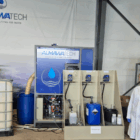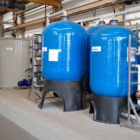Nipples are mechanical connecting elements that are used to securely and tightly connect pipes or fittings in industrial water and wastewater technology. As an essential component of complex piping systems, nipples contribute to the functionality and reliability of systems. They are used in a wide range of processes, from drinking water treatment to chemical wastewater treatment and industrial process water treatment.
This glossary article provides a comprehensive explanation of the technical principles, designs, materials and possible applications of nipples. The focus is on the requirements of industrial water technology, the challenges in operation and the selection of suitable nipple types.
Table of contents
Definition and function of a nipple
A nipple is a short piece of pipe with external threads at both ends. It is used to connect pipes, valves, pumps or other components together. Nipples are often used in combination with sockets, flanges or other connecting elements.
Main functions:
- Connection: Mechanical coupling of two pipes or a pipe with a fitting.
- Adaptation: Transition between different pipe materials, sizes or types.
- Sealing: Ensuring tightness at the joints, often by using thread sealants.
Designs and types of nipples
There are various types of nipple, which differ according to their area of application and their specific properties:
1. double threaded nipple
- Description: A nipple with external threads at both ends.
- Application: Often used to connect pipes directly to each other.
- Materials: Stainless steel, brass, galvanized steel, PVC.
- Advantage: Universal application possibilities and simple installation.
2. reducing nipple
- Description: A nipple with different diameters at the two ends to connect pipes of different sizes.
- Application: In water treatment for the integration of pipes with different cross-sections.
- Materials: stainless steel, plastic, brass.
- Advantage: Flexibility in piping planning.
3. hexagonal nipple
- Description: A nipple with a hexagonal body that facilitates tightening with a wrench.
- Area of application: Especially in tight installation situations where direct access is required.
- Materials: Stainless steel, brass.
- Advantage: Facilitates assembly and disassembly.
4. long nipple
- Description: An extended nipple that bridges larger distances between the connected components.
- Area of application: Applications in which pipes or components cannot be mounted directly next to each other.
- Materials: Stainless steel, galvanized steel, plastic.
- Advantage: Adaptability in complex system layouts.
5. special nipple
- Description: Nipples with special features such as internal threads, coatings or integrated seals.
- Area of application: Special requirements, e.g. in the chemical industry or with aggressive media.
- Materials: PTFE-coated steel, high-alloy stainless steels.
- Advantage: Adaptation to specific process requirements.
Materials and their properties
Choosing the right material is crucial for the durability and longevity of the nipple, especially in water and wastewater technology, where different media and operating conditions occur.
1. stainless steel (V2A, V4A):
- Properties: High corrosion resistance, mechanically resilient, chemically inert.
- Areas of application: Drinking water, process water, waste water with aggressive substances.
2. brass:
- Properties: Good corrosion resistance, suitable for non-aggressive media.
- Areas of application: Smaller water systems, drinking water, heating systems.
3. plastic (PVC, PP, PE):
- Properties: Resistant to many chemicals, lightweight, inexpensive.
- Areas of application: Chemical waste water treatment, process water treatment.
4. galvanized steel:
- Properties: Corrosion-protected due to zinc coating, cost-effective.
- Areas of application: Cooling water systems, non-aggressive applications.
5. PTFE-coated steel:
- Properties: Excellent resistance to aggressive chemicals.
- Areas of application: Applications with strong acids or alkalis.
Challenges and solutions when using nipples
1. corrosion:
- Challenge: Aggressive media can cause corrosion and jeopardize tightness.
- Solution: Use of corrosion-resistant materials such as stainless steel or PTFE-coated nipples.
2. leakages:
- Challenge: Improper installation or inferior sealants lead to leaks.
- Solution: Use of high-quality thread sealants (e.g. PTFE tapes) and careful assembly.
3. mechanical loads:
- Challenge: High pressure or vibrations can weaken the connection.
- Solution: Select nipples with a high pressure and strength class.
Conclusion
Nipples are essential components in industrial water and wastewater technology that ensure a reliable and secure connection of pipes and components. Their variety of designs and materials allows them to be used in a wide range of applications, from drinking water treatment to chemical wastewater treatment. Careful selection and professional installation are crucial to maximize the efficiency and longevity of systems and avoid operational disruptions.
For further information on our products, please feel free to contact us at any time!







